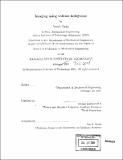Imaging using volume holograms
Author(s)
Sinha, Arnab, 1978-
DownloadFull printable version (18.72Mb)
Other Contributors
Massachusetts Institute of Technology. Dept. of Mechanical Engineering.
Advisor
George Barbastathis.
Terms of use
Metadata
Show full item recordAbstract
Volume holograms can be thought of as self-aligned 3D stacks of diffractive elements that operate coherently on incident fields as they propagate through the structure. In this thesis, we propose, design and implement imaging systems that incorporate a volume hologram as one of the elements that operate on the optical field incident on the imaging system. We show that a volume hologram acts like a "smart" lens that can perform several useful functions in an imaging system and demonstrate the same experimentally. To this end, we first develop the theory of volume holographic imaging and calculate the imaging properties of the field diffracted by a volume hologram for the special cases of coherent and incoherent monochromatic illumination. We concentrate on two simple imaging system configurations, viz. volume holograms recorded using a planar signal and either a spherical or a planar reference beam. We pay particular attention to the depth resolution of each system and discuss how appropriately designed objective optics placed before the volume hologram can enhance the depth resolution. We also derive the imaging properties of the volume holographic "smart" lens under conditions of incoherent broadband illumination. We show that multiple volume holographic sensors can be configured to acquire different perspectives of an object with enhanced resolution. We experimentally verify the developed theories and implement several volume holographic imaging systems for a wide range of imaging applications. We compare volume holographic imaging with some commonly used 3D imaging systems and discuss the merits of each system. We find that volume holograms with low diffraction efficiencies result in lower photon counts (cont.) and information loss and hence poorer imaging performance. We present an optical method to solve this problem by resonating the volume hologram inside an optical cavity. Finally, we conclude with some directions for future work in this emerging field.
Description
Thesis (Ph. D.)--Massachusetts Institute of Technology, Dept. of Mechanical Engineering, 2004. Includes bibliographical references (p. 185-196).
Date issued
2004Department
Massachusetts Institute of Technology. Department of Mechanical EngineeringPublisher
Massachusetts Institute of Technology
Keywords
Mechanical Engineering.